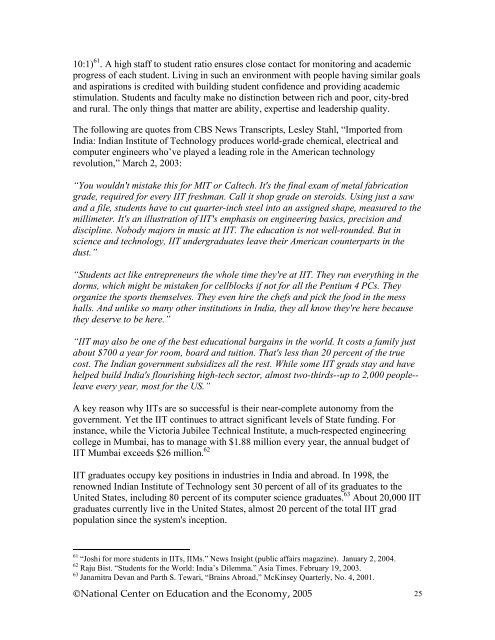India Education Report (2005) - NCEE
India Education Report (2005) - NCEE
India Education Report (2005) - NCEE
Create successful ePaper yourself
Turn your PDF publications into a flip-book with our unique Google optimized e-Paper software.
10:1) 61 . A high staff to student ratio ensures close contact for monitoring and academic<br />
progress of each student. Living in such an environment with people having similar goals<br />
and aspirations is credited with building student confidence and providing academic<br />
stimulation. Students and faculty make no distinction between rich and poor, city-bred<br />
and rural. The only things that matter are ability, expertise and leadership quality.<br />
The following are quotes from CBS News Transcripts, Lesley Stahl, “Imported from<br />
<strong>India</strong>: <strong>India</strong>n Institute of Technology produces world-grade chemical, electrical and<br />
computer engineers who’ve played a leading role in the American technology<br />
revolution,” March 2, 2003:<br />
“You wouldn't mistake this for MIT or Caltech. It's the final exam of metal fabrication<br />
grade, required for every IIT freshman. Call it shop grade on steroids. Using just a saw<br />
and a file, students have to cut quarter-inch steel into an assigned shape, measured to the<br />
millimeter. It's an illustration of IIT's emphasis on engineering basics, precision and<br />
discipline. Nobody majors in music at IIT. The education is not well-rounded. But in<br />
science and technology, IIT undergraduates leave their American counterparts in the<br />
dust.”<br />
“Students act like entrepreneurs the whole time they're at IIT. They run everything in the<br />
dorms, which might be mistaken for cellblocks if not for all the Pentium 4 PCs. They<br />
organize the sports themselves. They even hire the chefs and pick the food in the mess<br />
halls. And unlike so many other institutions in <strong>India</strong>, they all know they're here because<br />
they deserve to be here.”<br />
“IIT may also be one of the best educational bargains in the world. It costs a family just<br />
about $700 a year for room, board and tuition. That's less than 20 percent of the true<br />
cost. The <strong>India</strong>n government subsidizes all the rest. While some IIT grads stay and have<br />
helped build <strong>India</strong>'s flourishing high-tech sector, almost two-thirds--up to 2,000 people--<br />
leave every year, most for the US.”<br />
A key reason why IITs are so successful is their near-complete autonomy from the<br />
government. Yet the IIT continues to attract significant levels of State funding. For<br />
instance, while the Victoria Jubilee Technical Institute, a much-respected engineering<br />
college in Mumbai, has to manage with $1.88 million every year, the annual budget of<br />
IIT Mumbai exceeds $26 million. 62<br />
IIT graduates occupy key positions in industries in <strong>India</strong> and abroad. In 1998, the<br />
renowned <strong>India</strong>n Institute of Technology sent 30 percent of all of its graduates to the<br />
United States, including 80 percent of its computer science graduates. 63 About 20,000 IIT<br />
graduates currently live in the United States, almost 20 percent of the total IIT grad<br />
population since the system's inception.<br />
61 “Joshi for more students in IITs, IIMs.” News Insight (public affairs magazine). January 2, 2004.<br />
62 Raju Bist. “Students for the World: <strong>India</strong>’s Dilemma.” Asia Times. February 19, 2003.<br />
63 Janamitra Devan and Parth S. Tewari, “Brains Abroad,” McKinsey Quarterly, No. 4, 2001.<br />
©National Center on <strong>Education</strong> and the Economy, <strong>2005</strong> 25


